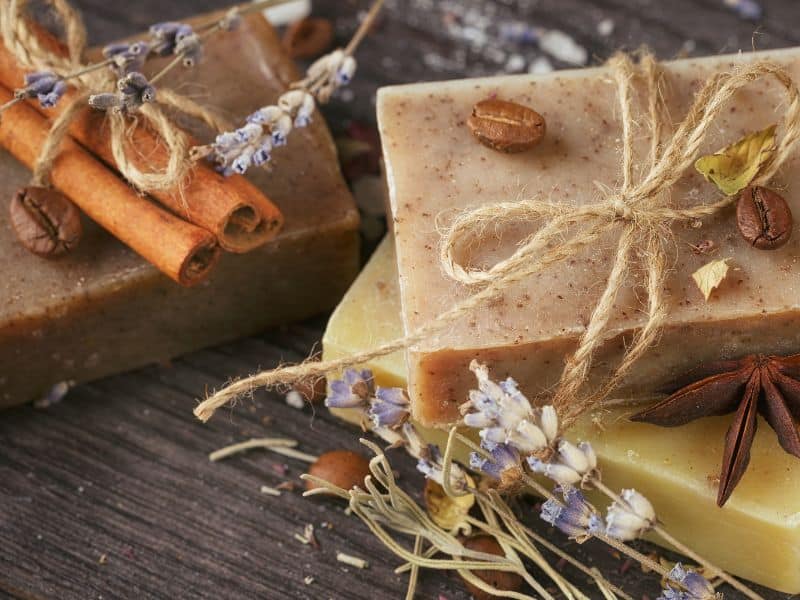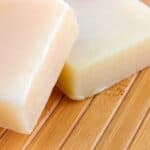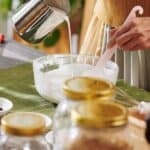Wondering why your beautifully crafted homemade soap has turned brown? Discoloration in soap making can be caused by various factors, and it can affect the appearance and scent of the soap. We will explore the reasons behind soap discoloration and how you can prevent and fix it.
Homemade soap turns brown due to the ingredients used. Fragrances with high levels of citrus, floral, or vanilla can cause this issue can occur in both melt and pour and cold process soaps. To avoid this, it is helpful to test a small amount of soap before making a batch.
If the fragrance discolors, you can try a different manufacturer or blend of fragrances. In addition, always try a small test batch of any new fragrance or soap recipe to make sure that it hardens and cures in the color that you expect it to.
Homemade Soap with Brown Discoloration Explained
Brown discoloration in soap is a common issue that many soap makers face. In this article, we will explore the factors that contribute to soap discoloration and how to identify brown soap.
Factors that Contribute to Discoloration in Homemade Soap
There are various factors that can lead to discoloration in homemade soap, such as the quality of ingredients, storage conditions, and exposure to air and light. Fragrances and colorants are also known to cause discoloration, especially those that have a high concentration of vanilla, florals, or citrus.
Role of Ingredients in the Discoloration of Homemade Soap
The ingredients used in soap making can contribute to discoloration. Natural oils and butters such as olive oil, cocoa butter, and shea butter can turn the soap brown over time due to oxidation. Some essential oils and fragrance oils can also react with other ingredients in the soap, causing discoloration.
Effect of High pH Levels on Soap Discoloration
Soap with a high pH level can also lead to discoloration. When the pH level is too high, it can cause the soap to turn brown due to the formation of melanoidins. This can be prevented by ensuring the correct ratio of oils, lye, and water is used during soap making.
How to Identify Brown Soap
Appearance of Brown Soap
Brown soap has a noticeable brown tint that can range from light brown to dark brown. It may also have brown spots or streaks.
Texture and Scent of Brown Soap
Brown soap may have a different texture than non-discolored soap, often appearing dry or crumbly. It may also have a different scent, sometimes smelling burnt or rancid.
How to Prevent Homemade Soap from Turning Brown
Avoiding Discoloration in Soap Making:
- Use antioxidants: Adding antioxidants such as vitamin E or rosemary extract to your soap recipe can help prevent oxidation and discoloration.
- Use a water reduction technique: Reduce the amount of water used in soap making to minimize excess moisture that can lead to discoloration.
- Choose essential oils carefully: Some essential oils, such as citrus oils, can cause soap to fade or discolor over time. Choose oils that are less likely to cause discoloration, such as lavender or peppermint.
Best Practices for Storage and Handling of Soap:
- Keep soap in a cool, dry place away from sunlight and moisture.
- Wrap soap in plastic wrap or parchment paper to prevent exposure to air.
- Avoid storing soap in airtight containers, as this can lead to excess moisture and discoloration.
How to Fix Brown Soap
Steps to Fix Discolored Soap:
- Cut off the discolored portion of the soap.
- Grate the remaining soap into small pieces.
- Melt the grated soap in a double boiler.
- Add fresh colorants, fragrance, or essential oils to the melted soap.
- Pour the melted soap into molds and allow it to harden.
How to Rebatch Brown Soap:
- Grate the brown soap into small pieces.
- Melt the grated soap in a double boiler.
- Add fresh oils, fragrance, or essential oils to the melted soap.
- Mix the soap well and pour it into molds.
- Allow the soap to cool and harden.
Tips to Avoid Soap-Turning Brown
Fortunately, there are several tips that you can follow to avoid soap turning brown when soap making. These tips will not only help you produce high-quality soap, but also ensure that it maintains its color and appearance over time.
Use Antioxidants
Adding antioxidants to your soap recipe can help prevent oxidation and discoloration. Antioxidants such as vitamin E or rosemary extract are great options to consider when making soap. These ingredients can help preserve the color of your soap and prevent it from turning brown.
Reduce Water Content
The amount of water used in soap making can affect the soap’s color. Using too much water can lead to excess moisture, which can cause the soap to turn brown over time. It is important to follow your recipe carefully and reduce the amount of water used in your soap making process if necessary.
Choose Essential Oils Carefully
Some essential oils can cause soap to fade or discolor over time. Essential oils such as citrus oils are notorious for causing discoloration. When making soap, it is important to choose essential oils that are less likely to cause discoloration. Essential oils such as lavender or peppermint are great options to consider when making soap.
Keep Your Soap in a Cool, Dry Place
Keeping your soap in a cool, dry place away from sunlight and moisture can help prevent it from turning brown. It is also important to wrap your soap in plastic wrap or parchment paper to prevent exposure to air. Storing your soap in airtight containers can also lead to excess moisture and discoloration.
Avoid Overheating Your Soap
Overheating your soap during the soap making process can cause it to turn brown. It is important to follow your recipe carefully and not overheat your soap. Using a double boiler can help prevent overheating and ensure that your soap maintains its color and appearance.
Frequently Asked Questions
Yes, using too much fragrance oil can cause soap to turn brown. It is important to follow fragrance oil usage rates in soap making recipes.
No, storing soap in airtight containers can actually lead to excess moisture and discoloration.
No, soap discoloration does not affect its effectiveness. It is purely a cosmetic issue.
Soap does not go bad, but it can lose its scent or color over time.
Soap can last for several months to a year before it starts to lose its scent and color.
Yes, adding colorants to your soap can help prevent it from turning brown over time.
No, soap discoloration is purely a cosmetic issue and does not affect the safety or efficacy of the soap.
Conclusion
In conclusion, soap can turn brown over time due to oxidation or exposure to air and moisture. Fortunately, there are several tips that you can follow to prevent this from happening. Adding antioxidants, reducing the water content in your soap recipe, choosing essential oils carefully, keeping your soap in a cool dry place away from sunlight and moisture, avoiding overheating your soap, and using colorants can all help prevent discoloration. Following these tips will ensure that your homemade soap maintains its color and appearance for longer.






